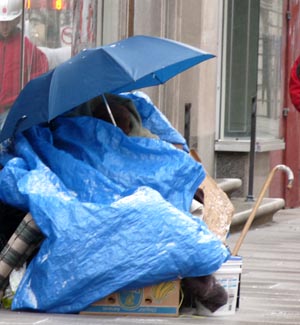 |
| Politics | Business | Schools | Justice | Health | Et Cetera |
| D.C. Shelters Hard Hit by Harsh Weather and Economy
Maryland Newsline Thursday, Feb. 5, 2009 WASHINGTON - The day after the season’s first snowfall hit the nation’s capital, the 801-East Housing Assistance Center had a full house. Both sides of several large rooms were lined with metal bunks covered with blankets and clothes. The mostly middle-aged men sat alone on their beds or chatted in the halls, escaping the freezing rain outside. As temperatures drop and the economy continues to suffer, shelters for the city’s homeless are toughing it out. Though shelters like the nonprofit 801-East are scraping by on what Clinical Coordinator Darcy Litzenberger called a “skin and bones” budget, the future is looking bleak as the nation’s housing crisis continues to put people out on the streets. “We started to notice the impact of the foreclosure crisis in Washington and nationwide in 2007,” said Michael Stoops, executive director of the National Coalition for the Homeless. “Whenever there is a recession, it increases homelessness." When people's homes are lost to foreclosure, he said, many move in with friends and family, or into RVs or other vehicles. Shelters are a last resort. "We expect a tidal wave or tsunami coming in the next one or two years" to homeless shelters, Stoops said. Shelters have been trying in recent months to cope with the freezing cold by providing more beds. At 801-East, a men’s shelter in Southeast Washington run by Catholic Charities of the Archdiocese of Washington, 52 beds were added to the usual 380 to accommodate more men on designated “hypothermia days,” when temperatures drop below freezing. “People who may sleep outside in summertime come in in the winter,” Litzenberger said. The city’s largest shelter, the nonprofit Center for Creative Nonviolence, has 1,350 beds year-round, but adds another 200 in the winter months, said Director of Administration Mark Raymond. Even so, on the coldest nights, between 20 and 40 people have to be bussed to a different shelter, Raymond said, because the facility is full. When temperatures hover below freezing many shelters choose to stay open 24 hours instead of just overnight, though the District does not require it, Stoops said. Despite the recent crush, Litzenberger said that the city has enough shelters to accommodate its homeless population, “just not enough shelters where people are,” he said. Many shelters, like 801-East, are in the outer reaches of the city. Michael O’Neill, director of the National Coalition for the Prevention of Homelessness, said the total isn't enough. "There’s no city in the country that has enough shelter beds," he said. "The funding’s not there, they don’t think there’s a need. It’s not something in our society, in our communities, that people think is an issue." In total, government-funded shelters provide 1,429 beds across the city, increasing to 1,925 on hypothermia days, said George Shepard, policy analyst for homeless services at the city's Department of Human Services. Five family shelters have a total of 175 rooms for families composed of at least one adult and one minor, or a pregnant woman in her third trimester.
The total number of shelter beds in the District, both government-funded and nonprofit, is around 3,000, said Michael O’Neill, director of the National Coalition for the Prevention of Homelessness. The figure does not include transitional housing, he said. The official count of homeless individuals in the District was more than 6,000 in January 2008, up nearly 300 from the year before, reported the Community Partnership for the Prevention of Homelessness. The 2009 count, completed Jan. 28, won’t be available for a few months. Shroeder Stribling, director of the nonprofit N Street Village, said she has noticed an increase over the past months in women looking for help. “A lot of people are identifying job loss or addiction, and recently, personal financial crises,” she said. N Street, which provides residential and support programs for low-income women and houses 120 women at a time, relies primarily on private funding. Stribling worries that services for the homeless will suffer from the economic downturn.“We know for sure that our corporate contributions were significantly decreased this year,” she said. No cold weather-related deaths have been reported this winter, said Stoops, though two or three usually occur each year. “There is a pretty effective hypothermia outreach program” in the city, he said, including vans to transport the homeless to shelters, a toll-free shelter hotline and blankets for individuals who refuse to go to shelters. The shelter hotline was particularly busy in December, when 26 days were official hypothermia days. Shepard said that in December the hotline received an average of 137 calls on those coldest days, compared with an average of 109 calls on days when temperatures are not so frigid. Copyright © 2009 University of Maryland Philip Merrill College of Journalism Banner graphic by Hortense Barber and Diego Mantilla. Banner photos of homeless person's cart and homeless man sitting are courtesy of Greg Sileo. |
